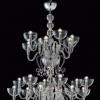
Murano Glass History - Part 2 - 13th to 17 Century
In 1291, the Maggior Consiglio (Venetian government) decreed that all the glass furnaces had to be moved from the city of Venice proper onto the island of Murano, because of the fire hazard to a city built of wood. More politically astute observers note that the consolidation of all glassblowers on a small island allowed the government to better oversee and manage its monopoly on the profitable industry.
Realizing that the glassblower’s secret techniques were prestigious and one of the underpinnings of the local economy, the Republic further tightened its control by issuing an edict forbidding glassblowers to practice their craft in other countries. To insure that the maestri’s secrets were never revealed, harsh sentences were meted out to individuals who leaked secrets to foreigners or left Venice without official permission. At the time it was rumored that the Maggior Consiglio even hired assassins to capture or kill artisans who left the island.
However, the close eye kept on Murano and its artists had unforeseen positive consequences. By artificially concentrating the entire glass blowing industry on a small island, it inadvertently intensified the level of competition between maestri; as a result the quality of glass was dramatically refined, and new techniques and ideas rapidly disseminated throughout the island.
The Renaissance had a profound affect on Italy, and Murano in particular. Angelo Barovier discovered Cristallo, a pure, bright, completely transparent crystal glass, which complemented the intricate designs seen in the mid to late 15th century. Goblets, bottles and pitchers all had ornate and sophisticated designs including enameling and gold leaf. New production techniques were slowly developed, including, filigrana a retortoli in 1527 and a ghiaccio around 1570.
Also during this time, engraving was also seen on some works of glass. Throughout Europe in the 16th and 17th centuries, the lightest, most graceful glass was sought after, allowing the reputation and prestige of Venetian glassblowers to flourish as the quality, designs, and bright colors became widely known.
The demand for Venetian glass became so great; some maestros disregarded the Guild’s edict on trade secrets and began migrating throughout Europe. Even Louis XIV commissioned master craftsmen to create glass pieces for the palace at Versailles. The Netherlands, Germany, France and Spain also had their own furnaces run by Muranese expatriates who described their works as à la façon de Venise (in the Venetian manner) and often modified classic designs and techniques to suit local materials and tastes
Viist our website at http://www.italiandecor-glasslights.com for more information
